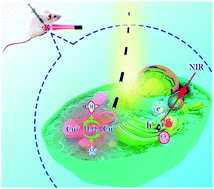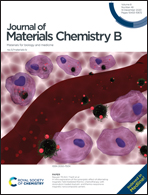A porous material excited by near-infrared light for photo/chemodynamic and photothermal dual-mode combination therapy†
Abstract
Photodynamic therapy (PDT) and photothermal therapy (PTT) are well-developed light therapy methods for cancer; however, both have a few areas that need improvement. A sustained PDT effect depends on the sustained generation of reactive oxygen species (ROS); therefore, adjusting the type of photosensitizer or the reaction mechanism to prolong the duration of the oxidation–reduction reaction is a possible solution for the continuation of the PDT effect. Further, if PTT could be combined with other treatments, it would bring about a more satisfactory therapeutic effect. To increase the treatment effect of the above two therapeutic methods, a collaborative treatment model of photo/chemodynamic therapy (PCDT) and PTT is needed and is the focus of this study. On the one hand, PCDT is a therapy that integrates PDT with Fenton-like reactions, and Fenton-like reactions can help PDT to produce more ROS by making better use of H2O2 in the tumor microenvironment. On the other hand, the PTT effect can also promote PCDT effects to some extent because rising temperature can elevate the redox reaction rate. Therefore, a copper oxide semiconductor photosensitizer was selected in this research to realize the abovementioned therapeutic purposes and experimental concepts. A porous silica carrier can facilitate the uniform attachment of the copper oxide photosensitizer to the SiO2 surface to form a relatively uniform nanostructure, and the nanoporous structure can increase the performance of the whole material to a certain extent. Based on these perspectives, SiO2@CuO nanotube (NT), an agent of both Fenton-like photosensitization and photothermal reagent, is synthesized by the hydrothermal co-precipitation template approach to shrink the tumor through the combined effect of PCDT and PTT. In this system, copper ions can participate in the Fenton-like reactions and make better use of H2O2 to generate more ROS. Herein, 808 nm light was chosen for irradiation because of its suitable excitation ability, applicable penetration and low intrinsic damage. The experimental results show that SiO2@CuO NT is a promising agent that combines PCDT and PTT for cancer treatment. This work provides guidance for the synthesis of Fenton-like photosensitizers for the PCDT effect.

- This article is part of the themed collection: Journal of Materials Chemistry B Lunar New Year collection 2021


 Please wait while we load your content...
Please wait while we load your content...